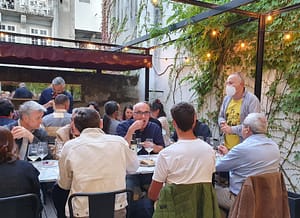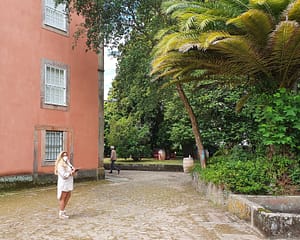Simplesmente …Vinho is the perfect wine fair. Here you find vignerons that really care for their grapes, and cultural aspects around it are also focused. In the cosy atmosphere one can feel that we are a big family of like-minded people. But important, after meeting the same artisans year after year you can really get to know the wines and follow them through storms and sunny days.
Speaking in wine terms, 2021 was a difficult year. The former site, an old port wine lodge by the river Douro, had been sold. So the organizers had to find a new place. This turned out to be the university’s faculty of architecture (Faculdade de Arquitectura da Universidade do Porto, FAUP). In the magnificent garden the usual barrels were set up. Another notable difference, of course, was the now well-known pandemic. They had done their best to take all the precautions needed; aside of the inevitable face-masks, there were fewer producers (around 60, some forty less than in the latest years), and there were three days instead of two, to avoid too much close contact. So in spite of the difficult conditions (“a crazy project”, according to ‘big chief’ João Roseira) I think that this might have been one of the best fairs so far, and Roseira and his team can be proud of how it all was carried out.
In my reports I have earlier given myself a special theme, mainly according to the regions I have visited before or after the fair itself. This time an extensive visits program was difficult, so I chose mainly to focus on wineries that earlier had been left out because they didn’t fit into my own regional limits. In this first article I will focus on some lesser known wineries from lesser known places.
Quinta da Comenda is not exactly unknown. This producer has a long history, but has maybe found itself in the shadows of the Douro producers lately. The quinta is located in the village of S. Pedro do Sul in DOC Lafões, a granitic region between northwestern Dão and the southern tip of Vinho Verde, thus not far from Douro either. Lafões is mostly noted for white wines, and maybe not far from Verde in style. Comenda was one of the Portuguese pioneers of organic cultivation, back in the 1980’s.
A fabulous red wine, quite unusual for the area, was served at the opening dinner. This was an initiative by organizer João Roseira, but it’s made by Comenda’s Angelo Rocha. Comenda de Ansemil 2020, a blend with 6 varieties known from different parts of the country, was only made in a quantity of 100 bottles. It comes with a dark colour, an aroma of dark and red fruits with some licorice, and with a huge freshness and a vivid energy. Other than this, the tasting the day after showed several wines at a generally very high quality, from the “straight” white Comenda de Ansemil 2019, a blend of arinto, cercial (cerceal/sercial) and dona branca, to a salmon pink Rosé 2020 of the same name and vintage (but classified as Terras de Lafões, as the DOC does not allow rosés), with its raspberry tones and a more generous taste than aroma. One that I liked a lot was the white 1/3 barrel-wine Quinta da Comenda 2019. Light straw colour, quite complex nose with yellow apples, way and a touch of smoke, and with a touch of vanilla in the mouth. An inspiring acidity binds it well together, like in all the other wines.
Távora-Varosa is a small region that lies on on granite or schist between Dão and Douro. With 500 to 800 metres above sea level it has a continental climate and extreme temperatures. Last year I had the opportunity to visit the region and meet Manuel Valente in his village Aldeia de Cima, where the family has a 200 year long history of growing grapes and olives a.o. You can read more about this visit here. His project Protótipo is a highly interesting one. He had brought a few more wines this time, like a dark but fresh 7 grape red aged in very old oak for 18 months and a wonderful Protótipo Branco 2018, a waxy-textured wine with a lovely acidity, golden in colour, with white flowers and stone-fruits on the nose. But the pét nats are for me the top. The white version is perhaps the more tamed. The rosé is based on touriga nacional, tinta roriz, and a complementing field blend. Protótipo Rosé Pét Nat 2019 can be described as red-orange, turbid; fresh red fruits (raspberry, strawberry); with a slight residual sugar (2,3 grams) and an excellent acidity. It’s more to the wild side, and truly inspiring.
Alentejo is not among the unknown regions. But Heredade do Cebolal is not found in the central area where the DOC is located, but on the Alentejo coast, bordering Setúbal. Therefore the wines are much fresher. I met the producer’s British importer in London at the Real Wine fair and tasted their “subterranean” wine (read more here). Since then the winemaking has been moving towards less extraction, more elegance. The family firm is now led by Luís and Isabel Mota Capitão. Santiago de Cacém 2018 Vinha da Casa Branca is a serious wine. Made from encruzado, arinto and antão vaz, with natural malolactic and low-sulphur, this was light golden wine with a typical fresh Atlantic character, and a mineral, saline finish. A bit petrol can be associated with arinto with some age. Palhete is an interesting category. It’s the Portuguese name for a mix of red and white grapes, here in the Palhete 2020 85% aragônez and the rest antão vaz. In this wine I find both red fruits (strawberry) and yellow (tomatoes, and a tropical hint where we agreed that guayaba was a good description). In the mouth it is more concentrated than the light colour would indicate, and a dry finish with a hint of bitterness. In Spain clarete is the name for this style, while in Portugal clarete signifies a lightly coloured wine made only with red grapes. Herdade do Cebolal has a wine of this sort too. Clarete 2019 from castelão on predominantly clay soils, is made with only two days of maceration. It’s a light ruby coloured wine, the aroma had a certain warmth, dominated by forest fruits.
Lisboa as a wine region (formerly Estremadura) is for many readers not unknown. But some of its nine DOC’s might be, and here come four wineries from there. Generally this region is windy, but sheltered by low mountains inland, and though the landscape is not dramatic there are endless variations.
Quinta Várzea da Pedra is found in the Óbidos denomination, more specifically in the town of Bombarral. The brothers Tomás (winemaker) and Alberto Emídio are fourth generation. These guys have something going on with their reds, but for me the whites were brilliant at this moment. The entry-level Quinta Várzea da Pedra Branco 2019 from arinto and fernão pires is a textbook wine; light straw, quite glyseric on the nose, with yellow apples and flowers, full on the palate, but with a very good acidity. It was followed by an equally good 100% arinto, and a wine made from four clones of sauvignon blanc. The day before at the opening dinner, another wine really caught my attention, a fernão pires. This one like the former is simply called Quinta Várzea da Pedra, and the vintage was 2017. It was a really fresh wine, both unctuous, creamy and with a wonderful acidity. The dominating aromas were citrus, with a hint of tropical fruits and some minerality. This wine was focused last week (read here).
Nearby in Cadaval we find Quinta do Olival da Murta. Only 15 km from the sea, by the Montejunto mountain range, Joana Vivas has 20 hectars under vine. The Serra Oca 2019 is a moscatel graúdo (the alexandria family), fermented in 1.000 liter oak vats: Golden colour; floral with a touch of honey; it has some volume, but also a distinctive acidity. An interesting one was a 3 days maceration curtimenta (orange wine) from fernão pires, arinto and moscatel, partly fermented in barrique, the rest in steel. This was golden with a hint of brown; somewhat more aromatic, citric and flowers, and again both full and a bit tannic with a cutting edge acidity. I include one of the reds, also called Serra Oca, now 2015. The grapes are touriga nacional, aragônez and castelão that spent one and a half years in French, used barrels. It’s dark cherry in colour; I noted mint (and it showed that the winery has this plant near the vineyards), together with dark fruits; quite well-structured and dry.
Alcobaça is a subdivision of Encostas d’Aire. Rodrigo Martins consults for other producers, but here he has his own project Espera. The wines show a strong Atlantic influence, and the acidity is always taking the wines to places. We started with the young Espera 2019, bical and arinto from clay and limestone soils. Arinto brings an uplifting acidity to the waxy, tasty character of the bical. The Espera Rosé was made with whole bunches of touriga nacional and fermented in barriques: Light pink; raspberry and strawberry on the nose, together with a slight toasted note; again some volume and a super acidity. I also liked the Espera Curtimenta 2020. As the name implies it’s an orange wine, with 17 days of skin-contact. But the colour was very light, so the manipulation can not have been particularly rough during that time. It has a wonderful aroma of flowers and lime peel, and in the mouth it’s full with concentrated fruit, again a lovely acidity and a saline finish. The Palhete 2020 from 15% castelão and five white varieties was an appealing wine, with its early harvest acidity, red fruit nose and all. The nose was quite discreet, but on the palate it had more concentration. A super fresh and light wine, Nat Cool 2020, is a castelão that goes into Dirk Niepoort’s nationwide series of glou-glou wines of the same name in 1 liter bottles. It’s made solely in steel, with two days of maceration. It’s light ruby; red fruits (raspberry), with a hint of smoke (from the soil), mellow and easy, but with enough acidity, a saline finish – and as cool as can be.
Baías e Enseadas (bays and coves, in English) is found further south, in Codiceira, Sintra. This is the land of the famous Colares wine, and we are approaching the capital city. The soil is essentially clay-limestone, with a predominance of clay in their vineyard Vinha da Ribeirinha, that results in richer wines. In Vinha do Campo there is more limestone, that accounts for more elegant wines. Then it’s possible to combine the two to give more complexity. The white that they brought, Reserva Branco Fernão Pires 2016, was from a low-acidity year, according to Daniel Afonso. He didn’t manage to bring my impression down though, as the wine was very attractive. 6 months in wood, four of them with batonnage, gave a full-bodied wine, but (as indicated) without the acidity that this region can offer. His Baías e Enseadas 2016 from 60% castelão and the rest pinot noir was light ruby with some evolution in the colour; fresh Atlantic aroma, with red fruits, a lactic note (yoghurt?); an attractive acidity and a salty aftertaste. He also brought the red Baías e Enseados 2017, pinot noir 30%, tinta roriz 30, castelão 40, was a light wine with some evolution in appearance; red fruits (plum), some smoke; attractive and mellow with just enough acidity, and a saline finish.
We will soon meet to talk about wines from more well-known regions, and I promise a cultural element.
Leave a Comment








